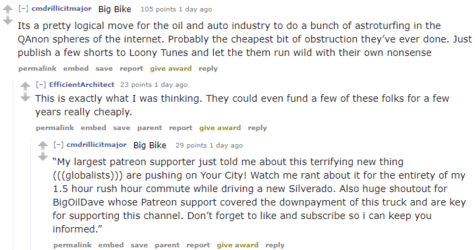- Joined
- Apr 12, 2021
Everyone who disagrees with us is a paid shill and/or conspiracy theorist:

Article (Archive):

Tell me you don't know any conservatives without saying that you don't know any:








Reminder that they're saying automated license plate readers that bill you £70 if you leave your neighborhood aren't trapping you in your neighborhood because you could just pay the fine or spend an extra hour on the bus if you're poor.
Source (Archive)
/r/fuckcars comments:


Proving the "conspiracy theorists" right:

Source (Archive)

Article (Archive):
Conspiracy Theorists Think Walkable Cities Are Really Open-Air Prison Dystopias Now
To many city-dwellers, a "15-minute city" with everything you need within walking distance is a dream. Conspiracy theorists are seeing it differently.
By Roshan Abraham
February 10, 2023, 3:47pm
IMAGE: ALEXANDER SPATARI VIA GETTY IMAGES
To many urbanites, a short commute and having your grocery shop, favorite bar, and library branch all within walking distance are markers of a higher quality of life. But recent attempts to reduce commute times to 15 minutes and make cities more walkable have led to waves of weird conspiracy theories about an encroaching police state that must be stopped at all costs.
The “15-minute city,” as this design paradigm has been dubbed, is not a city-dweller’s dream in this addled conception, but an open-air surveillance prison nightmare that is being imposed by shadowy forces.
Edmonton, Canada is the latest city getting backlash, including a planned in-person protest that will have a prominent anti-vaccine conspiracist in attendance. “You will spend 90% of your life in this 15 minute area as they are monitoring your ‘carbon footprint,’” the flyer reads. In January, another protest in the U.K. was held to oppose 15-minute city proposals in Oxford, where participants connected the plan to COVID-19 lockdowns and vague notions of government control.
The conspiracy theory has been circulating on Twitter, TikTok, and Instagram, stemming from proposals in the U.K. and Canada. Nearly all the videos inject made-up details.
One TikTok out of Canada with 670,000 views compared Edmonton’s proposal to the Hunger Games in a video with the song “Fulsom Prison Blues” playing in the background. Another video in the U.K. by a Gen Z TikToker compared the proposal to Black Mirror and attributed the idea to Tories.
“You’re going to have to apply for a fucking permit to leave your zone,” the TikToker says.
For decades, urbanists have pushed back on the car-centric development of cities that proliferated after the Second World War. Highways were erected, buildings went up at great distances from one another, and urban sprawl became the norm. The effects of these decisions are now being felt: Commuting long distances by car increases carbon emissions, leads to congested streets and, arguably, wastes a lot of time.
The emphasis on walkability in cities has gained traction in recent years. With an emphasis on the time it takes to commute, the 15-minute city idea suggests cities should be reimagined so that most people can get their needs met in a 15-minute walk or bike ride. The term was coined by Franco-Canadian urbanist Carlos Moreno in 2016. In a 2020 TED video, Moreno said that because of urban sprawl, “our sense of time is warped” as we adjust to the long commutes of car-concentric cities. Moreno was in turn inspired by American urbanist Jane Jacobs, who is the reason many contemporary urbanists in the U.S. praise walkability in urban planning.
In 2020, Paris adopted the term, prompted in part by the urgency of COVID-19 restrictions. To Paris Mayor Anne Hidalgo, it was a way of branding a set of pedestrian-centered redesigns, including street closures and the expansion of bike lanes, actions that mayors in the U.S. also took during the pandemic. Such plans tend to be popular over time but can invite blowback in the short-term. Until recently, that opposition has come from the expected groups: people who enjoy driving, hate parking spaces being taken away, or who fear that denser urban areas will put them in touch with the working class.
But in the last few months, an even more bizarre strain of opposition has been flourishing on TikTok, Instagram and Twitter: conspiracy theorists who believe that 15-minute cities will be pretext for open-air prisons enforced by a police state, where citizens will be prevented from leaving their enclosed zone.
To reduce carbon emissions and respond to the greater number of people working from home, Edmonton Mayor Amarjeet Sohi proposed creating “15-minute districts” by, in Sohi’s words, “widening sidewalks or multi-use trails that encourage walking, or sustainable infrastructure in communities where they make sense,” according to Western Standard. The city first proposed the plan in 2021, suggesting that city planners would focus on neighborhood-level planning that intermixes commercial and residential uses, in an effort to reduce commute times and widen the variety of services and amenities available in residents’ immediate areas.
While residents are right to openly debate the details, the overall strategy seems more realistic than putting the genie of remote work back in the bottle by forcing people to commute to commercial downtowns again, as some cities are trying.
In response to Sohi’s plan, conspiracy theorists began circulating a map purportedly of Edmonton, color-coded into separate neighborhoods, with a text box saying that vehicles will not be permitted to drive between zones. Except the map was actually of Canterbury, England, which had rolled out its own 15-minute city proposal. Edmonton has made no proposal to hinder travel between neighborhoods, and its plans are mainly focused around ensuring neighborhoods have a healthy mix of businesses and services available.
Canterbury’s plan involves closing off traffic on roads through the city’s center to reduce congestion through the use of license-plate readers that will fine motorists, which it calls “traffic filters.” Taxis, delivery vehicles, bikes and pedestrians would still be able to use the roads. Drivers can still cross into different neighborhoods, but it would take a little longer, possibly prompting them to walk or bike instead. Of course, many cities have various schemes to limit car use as traffic congestion has increased—Colombia’s famous pico y placa (peak and plate) rules ban cars from driving certain days of the week based on the digits on their license plates.
But conspiracy theorists saw something more sinister in the proposals, even expressing alarm that the 15-minute city concept has been discussed and promoted by the World Economic Forum, which is already at the center of conspiracy theories around its COVID recovery framework, the Great Reset. Sinister intimations were already percolating when they were boosted by Canadian psychologist Jordan Peterson, who retweeted a tweet containing 15-minute city maps and the caption “It’s already happening…” and the hashtags #GreatReset and #JailSchwab, referring to WEF chairman Klaus Schwab.
“The idea that neighborhoods should be walkable is lovely. The idea that idiot tyrannical bureaucrats can decide by fiat where you're ‘allowed’ to drive is perhaps the worst imaginable perversion of that idea--and, make no mistake, it's part of a well-documented plan,” Peterson wrote.
After receiving its own share of misinformation—including from former Independence Party leader Nigel Farage, who called the Canterbury plan a “climate lockdown”—leaders in the Oxfordshire County Council in the U.K. had to put out a statement and video to fact-check claims about the proposal. In the video, Councillor Liz Leffman said they were receiving panicked calls from residents fearing that they would be locked in their own homes. Councilors said the traffic filters would be rolled out in six trial locations in 2024. That video was in turn critiqued on TikTok with sinister music playing in the background.
While the proposals are different in every city, in no place would people be barred from entering a different neighborhood by automobile or any other method. People driving cars on roads that have been closed in the U.K. can get exemptions, but even without an exemption, they can just use another road. Another video suggests that the idea will lead to “invisible barriers” and the government tracking carbon footprints for individuals, so that people will not be allowed to eat beef if they drive too far. Needless to say, this is not being planned. License plate readers have their fair share of problems, but Edmonton has not said they will be fining or ticketing people.
The overall goal of providing people with local options for buying groceries or taking a walk is a good one; unfortunately, however, car culture is so deeply-ingrained that even the suggestion of limiting automobile use results in some dark and imaginative paranoia.

Tell me you don't know any conservatives without saying that you don't know any:








Reminder that they're saying automated license plate readers that bill you £70 if you leave your neighborhood aren't trapping you in your neighborhood because you could just pay the fine or spend an extra hour on the bus if you're poor.
Source (Archive)
/r/fuckcars comments:


Proving the "conspiracy theorists" right:

Source (Archive)
Last edited:




























